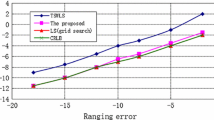Abstract
Wireless sensor network is a key enabling technology for Ambient Intelligence, where location information is crucial for many applications. RSS-based ranging localization takes advantage of its low cost and low complexity, but it has an infeasible assumption of an accurate path loss exponent of the physical environment. In this paper, we study the impact of path loss exponent accuracy on the localization accuracy. We formulate the relationship between the path loss exponent estimate and localization error, and found the localization error of exponential order which we call the error magnification effect. By our in-depth investigation, we propose a passive and an active measures to suppress the error magnification effect, where the passive measure stabilizes the localization error of the spring-relaxation algorithm (SR), and the active measure introduces variable elasticity into the SR algorithm to cancel off the exponential ranging error. The combination of both measures forms our localization solution called variable elasticity spring-relaxation (VE-SR) localization. We conduct extensive simulation experiments to show the effectiveness of VE-SR in suppressing the error magnification effect in various experiment setup. For a wide variety of physical environments, VE-SR offers location estimation with an average accuracy of no more than 10% of transmission range.











Similar content being viewed by others
Notes
Reference objects here refer to not only beacons, but also neighboring sensors, for cooperative localization [13].
References
Augusto JC, Nakashima H, Aghajan H (2010) Ambient intelligence and smart environments: a state of the art. In: Nakashima H, Aghajan H, Augusto JC (eds) Handbook of ambient intelligence and smart environments. Springer, Berlin, pp 3–31
Cook DJ, Augusto JC, Jakkula VR (2009) Ambient intelligence: technologies, applications, and opportunities. Pervasive Mob Comput 5(4):277–298. doi:10.1016/j.pmcj.2009.04.001. http://www.sciencedirect.com/science/article/B7MF1-4W2W5PH-1/2/7ac602bb16ca409e2f70c13aa24ae0d5
Benini L, Farella E, Guiducci C (2006) Wireless sensor networks: enabling technology for ambient intelligence. Microelectron J 37(12):1639–1649. doi:10.1016/j.mejo.2006.04.021. http://www.sciencedirect.com/science/article/B6V44-4KXF31P-1/2/fbab6ac1109d80a378520e2883778072
Casari P, Castellani AP, Cenedese A, Lora C, Rossi M, Schenato L, Zorzi M (2009) The wireless sensor networks for city-wide ambient intelligence (WISE-WAI) project. Sensors 9:4056–4082
Fang SH, Lin TN, Lin PC (2008) Location fingerprinting in a decorrelated space. IEEE Trans Knowl Data Eng 20(5):685–691. doi:10.1109/TKDE.2007.190731
Li X (2006) RSS-based location estimation with unknown pathloss model. IEEE Trans Wirel Commun 5(12):3626–3633
Bahl P, Padmanabhan VN (2000) RADAR: an in-building RF-based user location and tracking system. In: INFOCOM’00: proceedings of the 19th annual joint conference of the IEEE Computer and Communications Societies, vol 2, pp 775–784
Lorincz K, Welsh M (2007) MoteTrack: a robust, decentralized approach to RF-based location tracking. Pers Ubiquitous Comput 11(6):489–503
Savarese C, Rabaey JM, Langendoen K (2002) Robust positioning algorithms for distributed ad-hoc wireless sensor networks. In: Proceedings of the general track of the annual conference on USENIX annual technical conference, pp 317–327. USENIX Association, Berkeley, CA, USA. http://portal.acm.org/citation.cfm?id=647057.713854
Niculescu D, Nath B (2003) DV based positioning in ad hoc networks. Telecommun Syst 22(1–4):267–280
Savvides A, Park H, Srivastava MB (2002) The bits and flops of the n-hop multilateration primitive for node localization problems. In: Proceedings of the 1st ACM international workshop on Wireless sensor networks and applications, WSNA’02, ACM, New York, NY, USA, pp 112–121. doi:10.1145/570738.570755
Priyantha N, Balakrishnan H, Demaine E, Teller S (2003) Anchor-free distributed localization in sensor networks. Technical report. MIT Laboratory for Computer Science
Zhang Q, Foh CH, Seet BC, Fong ACM (2010) Location estimation in wireless sensor networks using spring-relaxation technique. Sensors 10(5):5171–5192
Rappaport TS (2002) Wireless communications: principles and practice, 2nd edn. Prentice Hall PTR
Zigbee specifications, version 1.0 r13 (2006). http://www.zigbee.org
Telosb datasheet (2006) http://www.willow.co.uk/TelosB_Datasheet.pdf
Gonzalez J, Krause A, Chen K, Guestri C Link quality estimation. http://www.select.cs.cmu.edu/data/index.html
Author information
Authors and Affiliations
Corresponding author
Rights and permissions
About this article
Cite this article
Zhang, Q., Foh, C.H., Seet, BC. et al. Variable elasticity spring-relaxation: improving the accuracy of localization for WSNs with unknown path loss exponent. Pers Ubiquit Comput 16, 929–941 (2012). https://doi.org/10.1007/s00779-011-0449-2
Received:
Accepted:
Published:
Issue Date:
DOI: https://doi.org/10.1007/s00779-011-0449-2




